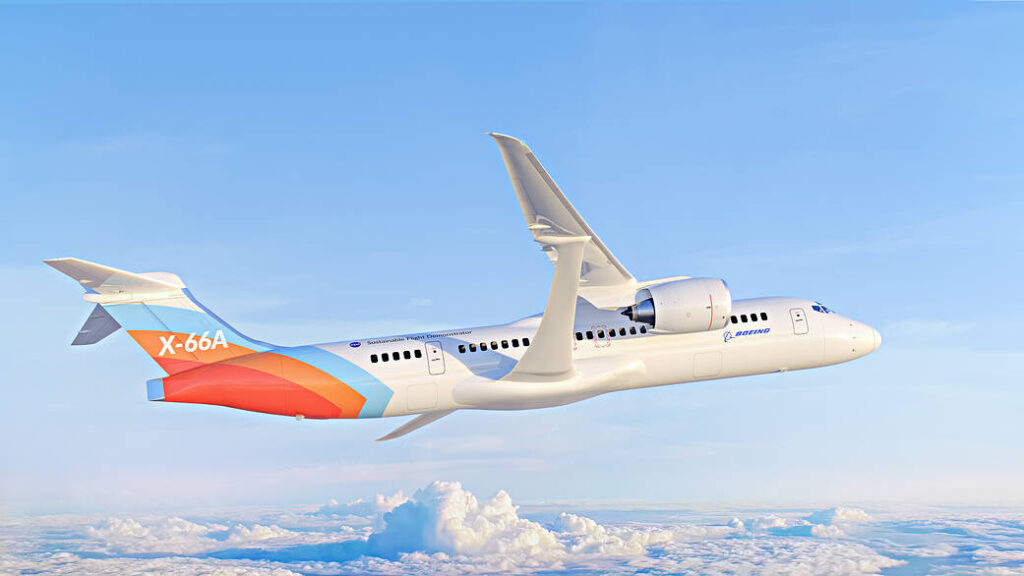
At EAA’s AirVenture 2023, NASA revealed that some major project milestones have been achieved as a result of collaboration and technological innovations. (Photo: Boeing)
NASA has recently made several announcements regarding some of the organization’s major projects. These updates, which were revealed at the EAA’s AirVenture 2023, shows that NASA is making significant progress toward its goal of creating cleaner and more sustainable technologies for the aviation industry. In its recent announcements, NASA highlighted three of its programs that have recently reached major milestones.
First, NASA revealed that its X-66A program has made significant progress through collaborative efforts with industry partners/stakeholders. This aircraft, which will be produced through NASA’s Sustainable Flight Demonstration project, is aiming to develop sustainable and cleaner solutions to replace existing single-aisle aircraft. NASA will be working closely with Boeing to design, manufacture, test, and fly the prototype. Additionally, the two organizations will work within a new sustainability coalition with several major U.S. carriers: Alaska Airlines, American Airlines, Delta Air Lines, Southwest Airlines, and United Airlines. These potential customers will provide feedback regarding the aircraft’s operational efficiencies, maintenance, and compatibility with existing airport infrastructure.
As Todd Citron, Boeing’s Chief Technology Officer, explained, “Hearing directly from the operators during all phases of the Sustainable Flight Demonstrator project will help us understand exact requirements and tradeoffs. The airlines’ feedback will significantly contribute to the X-66A project learnings while furthering aviation sustainability.”
The X-66A will be developed mainly to test the Transonic Truss-Braced Wing (TTBW) airframe configuration. The prototype will be built in Palmdale, California, using a modified MD-90 aircraft and is the first of NASA’s X-planes dedicated to developing an aircraft with net-zero greenhouse gas emissions. Boeing estimates, when combined with anticipated innovations in propulsion systems and materials, a TTBW configuration could potentially reduce fuel consumption and emissions by up to 30% compared to existing aircraft currently in service. Boeing and NASA also unveiled a new livery for the X-66A along with a glimpse of what the aircraft will look like.
Additionally, NASA also provided updates regarding the hybrid electric aircraft that will be flown as a part of the Electrified Powertrain Flight Demonstration (EPFD). Through the EPFD, NASA works with several aerospace companies throughout the country to use existing aircraft as testbeds for new electrified aircraft propulsion (EAP) technologies. The government agency has collaborated with various industry partners to accelerate the process of placing hybrid propulsion systems with megawatt (MW) levels of power to low-capacity (30–70 passengers) regional airliners. In its most recent update of the project, NASA unveiled liveries for the hybrid electric aircraft.

(Photo: NASA)
Under this program, GE Aerospace is working to develop a hybrid electric powertrain for both ground and flight tests. These tests will utilize modified Saab 340B aircraft and are anticipated to begin in the middle of the decade. They will be performed as a partnership with Boeing and Aurora Flight Services, the aircraft manufacturer’s subsidiary, and take place in Manassas, Virginia. Along with GE Aerospace, magniX will also develop a hybrid powertrain to be installed and tested on a modified DeHavilland Dash 7 aircraft. The aerospace company will partner with AeroTEC and Air Tindi. Both of these projects have been teased with new liveries featured on the testbed aircraft.
The last major announcement NASA shared at AirVenture this year gave an update on the X-59 aircraft. The X-59 is a part of NASA’s Quesst Mission, and is a supersonic prototype with a 29.5-foot wingspan and a length of 99.7 feet. This program aims to develop an aircraft with a significantly quieter “sonic boom” to minimize disruptions to people on the ground. Powered by a jet engine developed by General Electric Aviation, it will fly over various communities across the United States to collect data describing human responses to the sound generated by supersonic flight. It then plans to share this data with the United States government and international regulators. In its most recent update, NASA released a video showing the prototype aircraft as it exited the hangar and moved to the flightline, indicating major progress in the aircraft’s development process.